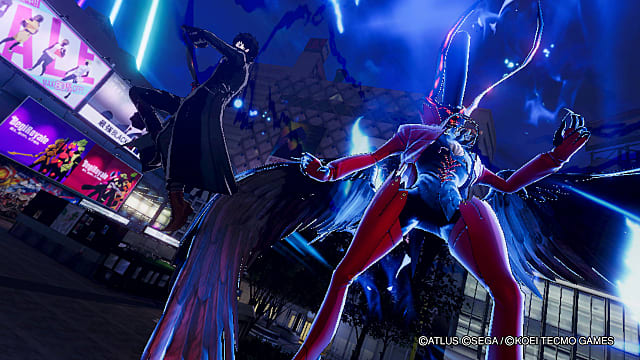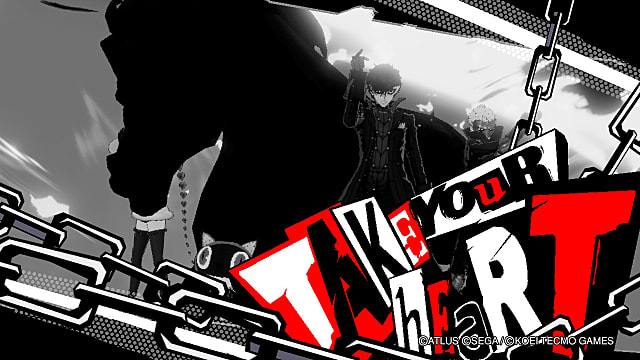We’ve followed P5S’s progress pretty closely since it was first announced, and the mix of musou-style Warriors combat with Persona’s deeper strategic combat intrigued me. I was curious with questions and was a bit concerned about how the two contrasting styles would mix.
Fortunately, the answers I got allayed (most) of those concerns.
School’s Out for Summer
Like any Persona game, there’s a hefty setup in P5 Scramble. Obviously, it’s all in Japanese, so your understanding of it will vary, but even someone with little-to-no Japanese knowledge can get the gist of what’s going on with the characters and story.
It’s the July following the events of Persona 5 (not Royal, which was developed concurrently with P5 S). Ren Amamiya returns to Yongen Jaya and Cafe Leblanc, reuniting with the Phantom Thieves. There’s a new app for everyone’s phones called Emma, distributed by the IT Company Maddice, which surely isn’t significant in any way at all.
Even without a full understanding of what’s going on during this initial reunion, it’s immediately clear Persona 5 Scramble adopts a different tone from its predecessor, something more akin to Persona 4. Sure, Persona 5 has its slice-of-life scenes, but the overall atmosphere is much darker and tenser.
Everyone’s already encountered and overcome their darkness, and it’s time to hang out as a group of normal almost-college-kids who just so happen to have amazing superpowers. The cozier, warmer take on The Phantom Thieves is a refreshing change of pace as well, since Persona 5 came close to subjugating the protagonists’ relationships to the overall story many times.
Silly anatomists. This is what a heart really looks like
That doesn’t mean the overall plot takes a backseat like it often does in Persona 4, though, and it still offers poignant commentary on social issues. This time, it’s related to the problems arising idolizing public figures, or more literally, when public figures take people’s hearts.
And that’s got me wanting to see how things unfold in the final product, because the tension between pursuing justice and pursuing public adoration was a constant theme in Persona 5.
Stories in Warriors crossover games tend to be fairly throwaway, variations of “Dark Power brought many heroes together because thing,” so this emphasis on story situates Persona 5 Scramble in a unique position. It’s not entirely surprising, given P5S is a direct sequel, but it is nice to finally see the musou genre’s potential used for something other than fluff.
Show Time
The uniqueness extends to combat as well. We’ve reported many times that Persona 5 Scramble combat is a hybrid of warriors hack-n’-slash and Persona’s ability and One More systems. It comes together in a pretty solid package, with just a hint of the usual malaise associated with Warriors button-mashing.
There’s a basic attack you can use alone or link with another move for some extra damage and variation. Ranged weapons make a return from Persona 5, and joy of joys, ammo replenishes as you go along.
On top of that, there’s a number of objects in the environment you can use to deal more damage or damage a wider area. It’s fast, loud, frenetic, and I love it.
The star of the show, and what makes P5 Scramble’s combat really stand out, is your Persona. As you’d expect, enemies are weak to different elements and attack types. Exploiting those weaknesses or scoring a Critical or Technical hit earns you a One More, but instead of another turn, you get a chance to deal extra damage in a move that affects all the enemies around that particular one.
Joker still retains the ability to wield multiple Personas, so switching between them and choosing the best attack is just as strategic as it was in Persona 5.
Same Ol’ Musou?
But does it really require that much strategy? Well… sort of. The police grunts are basically trash mobs. Out of 20, one might try and hit you with a stick, but it’ll probably miss. The challenge ramps up when multiple Shadows are on the field, along with new machine foes boasting devastating AoE attacks.
However, with three other party members on the field, you typically don’t have much to worry about, at least in the opening stage. Here’s hoping it gets tougher as the game progresses.
Boss fights are where combat really shines. This is where you’ll really have to balance attack, evasion, item use, and SP conservation to pull through. Bosses also have a shield meter that, once breached, leads to a powerful All-Out Attack that are just as flashy and excellent as they were in Persona 5.
The kicker, though, is when your SP runs out or when you aren’t using special skills. Basic attacks just aren’t varied enough to be consistently fun. Even though you’ll be kept busy trying to stay out of harm’s way, the genre’s combat shortcomings end up poking holes in Persona 5 Scramble’s stylish and skillful balancing act.
It’s way too early to say whether this will be a game-breaker, though. I suspect the story segments will go far in keeping things from feeling too stale, even if combat ends up too easy throughout. Plus, if you’re already a Persona fan, then the joy of exploring Tokyo and beyond with the Phantom Thieves will probably be enough to help overlook minor issues.
Persona 5 Scramble: The Phantom Strikers launches February 20 for PlayStation 4 and Nintendo Switch in Japan, though it currently has no Western release date. Stay tuned for more on the game in the future.




